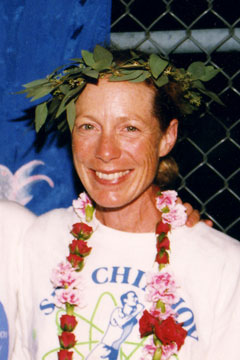In 1928, in the first year of women’s track and field events being allowed into the Olympics, 3 women collapsed in the 800 metres. Because of this it was felt by the authorities it was not safe for women to participate in events greater than 200 metres.
As a consequence, up until 1960, the longest distance for female runners at the Olympic Games was 200 metres. The idea of women running a marathon was at best frowned upon, but at worst was deemed to be medically dangerous. Women were placed in a catch 22 situation. They weren’t allowed to run, because it was thought marathon running was not safe. But, because they couldn’t run, they were unable to prove they could.
However, a few intrepid female runners ignored conventional wisdom to show that women could run respectable marathon times.
One of the early women marathon pioneers was Roberta Gibb; she sneaked into the Boston Marathon in 1966 and finished with an unofficial time of 3:21.25. When she entered a year later, officials forced her off course so she couldn’t get an official time.
However, times were changing; their was a boom in running and social attitudes to women were altering very quickly. Women were allowed to participate in various marathons, and in 1971, the NY marathon had a separate section for female runners. However, it was not until 1984 that the marathon became an official Olympic distance for women.
Ultra Running Boom
In the sport of distance running, perceptions of what is possible and what is not, have changed at a frantic pace. The 1980s and 1990s saw a boom in the popularity of ultra running. From marathons, new races of upto 1000 miles redefined the boundaries of running. Although in a minority, women proved that in the sport of distance running they were capable of running very long distances.
Sri Chinmoy Marathon Team
The Sri Chinmoy Marathon Team were often at the forefront of ultra distance running. With the suggestion of Sri Chinmoy, the Sri Chinmoy MT began organising ultra distance races which included: 6 and 10 day races, and also 700, 1,000 and 1,300 mile races. In 1996, Sri Chinmoy initiated a new challenge: the 2700 mile race. The next year the distance was increased to 3100 miles and the race has been run annually ever since. It is officially the world’s longest certified footrace and only a select number of runners have completed the distance.
Suprabha Beckjord 11 Times finisher of Self Transcendence 3100 Mile race

The only runner to have completed all 11 editions of the race is Suprabha Beckjord. Such a record is a monumental sporting achievement; before the start of the 2007 edition Suprabha had run 30,600 miles in this particular race alone. (She has also the 6th fastest record for a 6 day race of 459 miles. )
One of the most common questions asked the runners of the 3100 mile race is why? Suprabha gives this reply:
“I get a lot of inspiration from doing this kind of distance. It really is like a pilgrimage. You are not dealing with the things you have to deal with at work, at home, like phone calls and faxes. In my work, I place orders and pay bills, things like that.”
[1]
If Suprabha is able to finish her 12th race, it will make a grand total of 33,700 miles.
How far is 33,700 miles? Well the circumference of the earth at the equator is 24,901 miles.
But one thing is certain, however you look at 33,700 miles, it’s an awful lot of 200 metre races.
[1] Washington Run- feature with Suprabha Beckjord
- Interview with Suprabha at Multidays
- Suprabha Beckjord at Sri Chinmoy Races
- Suprabha at Sri Chinmoy Library